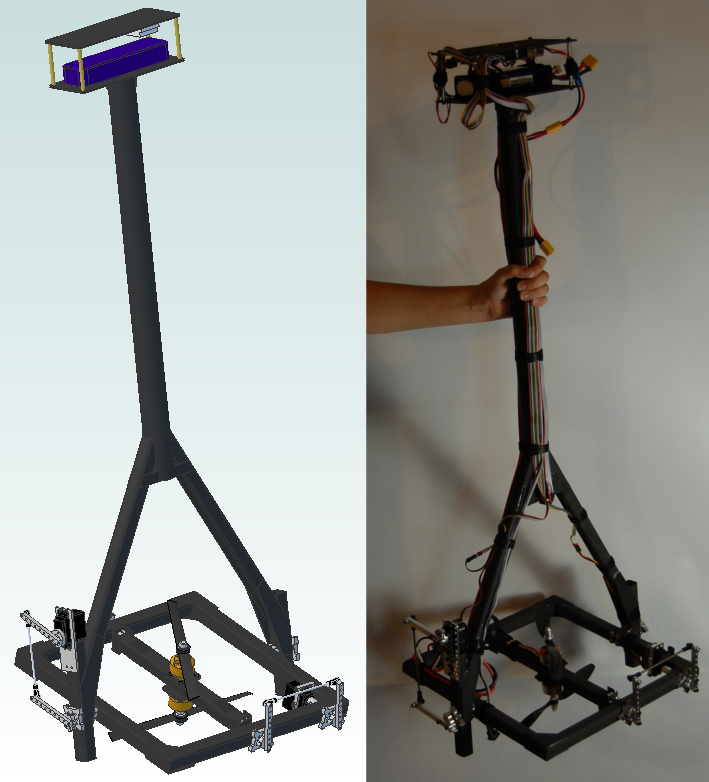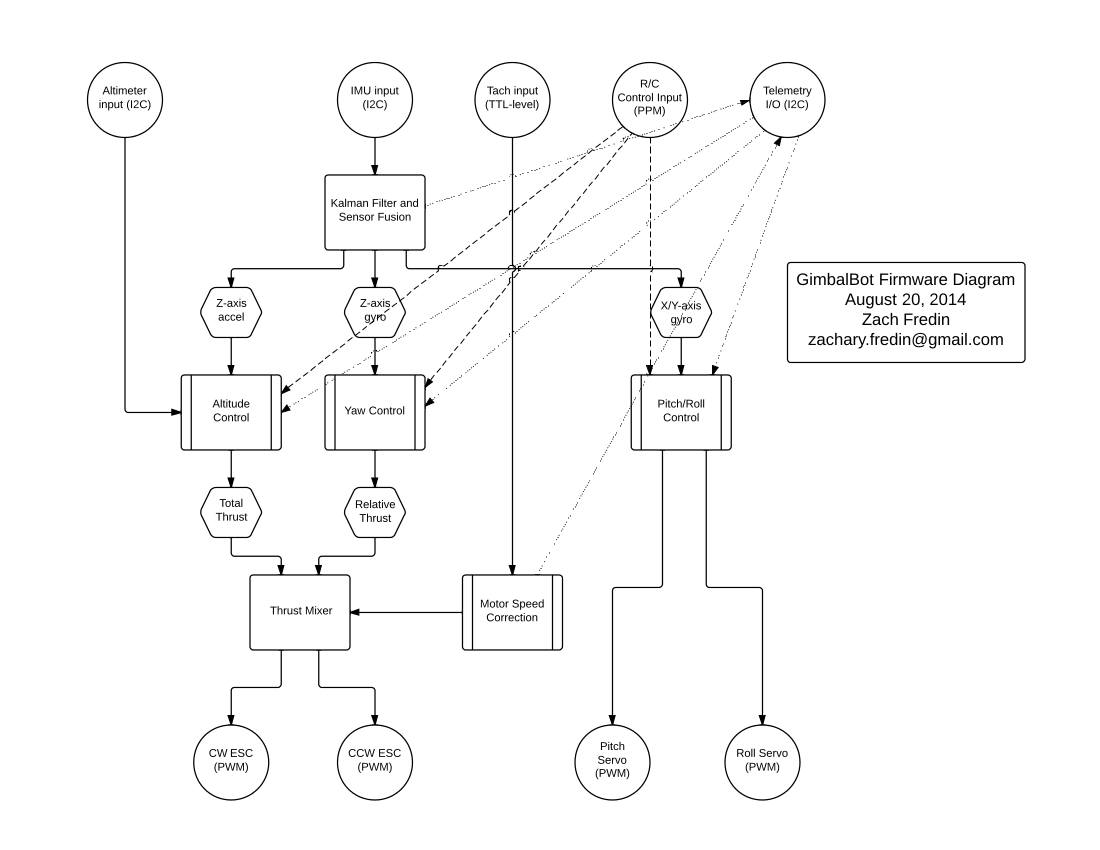
Overview
I started the GimbalBot project on April 30, 2014. GimbalBot is an open source unmanned aerial vehicle intended to explore a diverse range of topics including airframe design, aerodynamics, composites manufacturing, embedded systems, sensor fusion, and stability control. The craft combines characteristics from ball-balancing robots, rocket-stabilized landing vehicles, and single/dual-propeller drones that use actuated fins for attitude control.
GimbalBot's unique vectored fan design isn't meant to win any awards for efficiency, speed, maneuverability, cost, or other performance targets traditionally driven by business needs. Rather, I hope to share my own process of discovery and learning as I research and apply new (to me) concepts to a real-world project. If GimbalBot actually manages to get off the ground, I will be truly ecstatic.
System Design
 GimbalBot Hardware System Design (*.pdf)
GimbalBot Hardware System Design (*.pdf)
 GimbalBot Firmware System Design (*.pdf)
GimbalBot Firmware System Design (*.pdf)
Hackaday Prize Entry Video - Phase 1
Openness
GimbalBot is Open Hardware. Every aspect of this project is open, and this has been a fundamental design decision since day one. By sharing early concepts and models via a constant stream of project logs, I've been able to gather a vast number of invaluable suggestions that have been integral to the success of the project to date. I hope that by keeping my methods and decisions in the public eye, someone might learn from my mistakes and build on what I have learned from GimbalBot.
Connectivity
In its current iteration, GimbalBot isn't a connected device in that the craft does not directly interface with the Internet. However, the project does feature several local systems that are connected in various important ways.
Sensors
GimbalBot uses several sensors to keep tabs on its orientation in space, including a 3-axis accelerometer, a 3-axis MEMS gyroscope, a 3-axis magnetometer, and a barometric altimeter. All of these sensors communicate digitally with the Arduino Due over I2C and provide data at a rate of 50-100 Hz. I2C interpretation will be handled using the standard Arduino Wire library.
Actuation
The pitch ring servos and brushless motor electronic speed controllers (ESCs) are all off-the-shelf hobby R/C products, and as such use a standardized PWM interface for control. The standard Arduino Servo library will be used for encoding these signals.
Controls
I'm reinventing the wheel enough with this project; for now, I'll be using a commercially available (and as-of-yet unselected) R/C setup with a dedicated receiver. While these systems often have sophisticated mixing and scaling features in the controllers, I plan to feed the raw receiver output through a PPM converter (to save on I/O lines) to the Arduino and deal with scaling issues in firmware. Since the RF protocols for these systems are generally proprietary, I'll keep the receiver interface open to ensure cross-compatibility with other radio platforms.
Telemetry
One of the most interesting parts of the GimbalBot project involves the control loops used for altitude, pitch, roll, and yaw control. In order to study and understand the interactions between these control systems and GimbalBot's various sensors, the craft will be fitted with a dedicated high-speed telemetry system for gathering sensor data and changing loop tuning parameters on the fly. While this system has not been designed in detail, I plan to use something like the XBee-PRO with a suitable computer interface.
License
I plan to release GimbalBot under the MIT license. This license will cover the on-board firmware, computer-side software, and all CAD part models, drawings, assemblies, and *.stl files. In other words, if you want to build a GimbalBot and sell it--please do. I still need to double check the licenses on the libraries I'm using for compatibility, so this may change in the near future; in any case, everything I do here will be entirely open and free for anyone to use without restriction.
Tools
In addition to a lot of hand and power tools, I used a number of software packages to design and build GimbalBot. They are covered below.
Open Source Tools

Open source software is important to our community. When these tools are also free (and all of the programs I used are), they are also easily accessible to all. I used these programs whenever possible, and owe a great deal to the skilled developers behind each one.
KiCad EDA Software Suite, a schematic and PCB design tool released under the GNU GPL v2 license.
Ubuntu 12.04 LTS, a Debian-based Linux distribution released under the GNU GPL license.
GIMP, a raster graphics editing program released under the GNU LGPL/GPL v3+ license.
LibreOffice, an office suite released under the GNU LGPLv3 license.
Arduino, an electronics design and programming platform released under the Creative Commons Attribution Share-Alike license.
Closed Source Tools
In a few cases, I used non-open source software tools for development, generally in the interest of expediency as they were available and already familiar to me. In all cases, I'm providing copies of all files produced, saved in universal formats and covered under GimbalBot's [TBD] open source license.
Cubify Design, a parametric 3D modeling program used to produce GimbalBot's CAD part files, drawings, assemblies, and *.stl files.
Lucidchart, used for putting together the System Design diagrams.
Design Features
- Materials of construction
- CFRP square and round tube, plate, and angle stock
- Space Glue
- Off-the-shelf aluminum and plastic mechanical bits
- Rotating stuff
- Hobby servos for attitude control
- Brushless motors, RC speed controllers, and CFRP propellers for thrust
- Control
- Arduino Due ARM-based microprocessor
- 9 degrees-of-freedom inertial measurement unit
- Optical tachometer for each motor
- Barometric altimeter
- To-be-specified commercial R/C system (direct control)
- To-be-designed radio telemetry link (data logging and tuning)
- Electrical system
- 4-cell 5000mA LiPo battery
- Servo/Arduino power supply for servo power
- Lots of 10, 14, 20, and 24 AWG silicone insulated wire
- Performance estimates
- 2300g total weight
- 3kgf+ maximum thrust
- 3-5 minutes run time
- Loud, scary, and quite likely to crash
Conclusion
GimbalBot represents the most concentrated effort I have ever put into a project. For me (along with many of my fellow competitors), this contest has already been a life-changing journey of learning and self-discovery. I cannot thank my collaborators enough; college buddies, cousins, long-time acquaintances, new friends, and (of course) my wonderful family. Without you, GimbalBot would still be a hasty sketch in a lost notebook.
 zakqwy
zakqwy